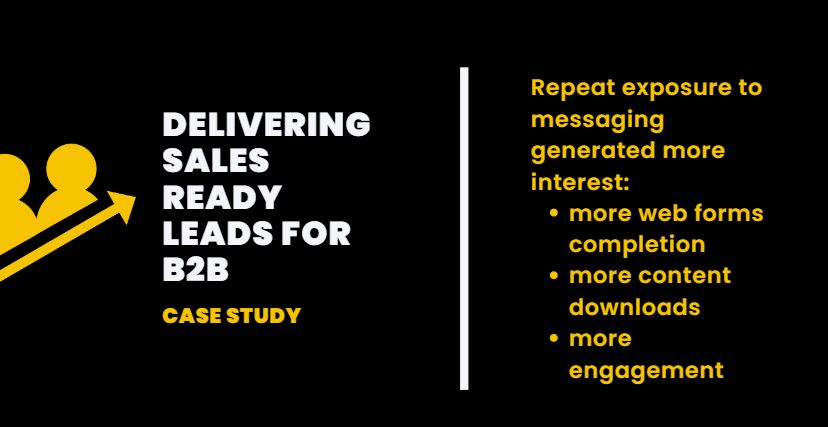Delivering sales ready leads
written by
Raluca Apostol
date
30 July 2024
written by
Raluca Apostol
date
30 July 2024

A company active in the tech automation space (RPA services) needed our help supporting its sales function. Their sales team had recently been created and was growing steadily, so they needed a constant flow of leads for the team to have conversations with and convert into contracts.
We used inbound and outbound strategies to deliver 10-15 sales-qualified leads monthly, leads that booked calls with the sales team. As our demand and lead generation efforts progressed, the conversations continued, and the sales team got more and more potential customers to try and close.
The client is a European-based tech automation company with over 1,000 employees and approximately €15 million in revenue annually. Working in the B2B sector, the company offers automation services (RPA consulting and implementation, as well as complex software development services) to clients in the finance, insurance, and retail sectors across Europe.
As part of their efforts to expand their customer base, the client wanted to target new customers from Western Europe (the UK, Germany, and Switzerland as the leading countries) in their already experienced industries. They had all the infrastructure in place (experienced consultants, an expanding sales team, a partnership with a strong international RPA provider) but needed more support in the marketing function.
Their current marketing team focused exclusively on building the brand through attending IT events and didn’t have a clear objective of delivering leads. It was decided that the sales team should focus on closing sales to reach their ambitious goals. In contrast, an agency would focus on generating demand from the target market and acquiring an audience.
The aim was to increase sales, with new contracts ranging from €20,000 to €100,000 contract value. Considering the time frame needed to close a deal (6 – 9 months in the tech space, given the customer profile and value of the contract), the company wanted to achieve the results over 1 year, with a steady increase in leads on a month-to-month basis.
The first step in achieving results was the narrowing of focus. The company worked with multiple industries in different countries and usually talked about their vast experience in diverse fields. However, clients want to make sure you understand their specific problem, which is why 3 primary customer personas were developed:
Digitalization executives in the banking industry
Technology and digitalization executives in the insurance industry
Technology officers in the retail industry
Following this, 3 landing pages were developed for each persona, detailing information about what the client can offer and presenting relevant case studies for that specific industry. The landing pages were promoted in digital ads and organic social media posts and used in cold outreach campaigns.
It is important to note that marketing is a long-term game, even more so in B2B. Consistency is needed to see optimal results. The leads were repeatedly exposed to the clients' messaging, and interest increased steadily. More people filled in the web forms, engaged with the social media posts, and read the content.
The marketing strategy included activities for inbound marketing (focused more on the long term) and outbound marketing (with a shorter-term view).
The inbound marketing strategy for demand gen included:
A content marketing plan to showcase thought leadership in each specifically targeted industry, with a frequency of 1 long form, value-packed article per month
Videos that presented the team and their process when working with clients to set rapport with the client even before the first conversation and promote their USPs
Relevant case studies showed the client's experience in each industry. The articles and case studies were also collated in whitepapers, which generated warm leads.
An organic social media plan that addressed the needs of customers in all sales life cycles (awareness, consideration, conversion), with specific types of content aimed at each stage
A digital ads plan to promote the content generated and to bring back customers to the site through remarketing, but also to be top of mind for those searching for specific keywords and showing an active interest in automation.
A lead nurturing plan was created to ensure that leads generated through all the efforts were kept warm until they were ready to convert, in which constant contact was ensured through LinkedIn interactions or personalized emails.
The outbound marketing strategy for audience acquisition included:
A LinkedIn cold outreach plan that expanded the network of key sales managers from the team and started conversations with target contacts. It also included nurturing activities for potential customers to help warm them up before beginning any conversation.
An email marketing sequence to generate meetings for the sales team.
Lead gen ads targeting the customer personas on LinkedIn.
The campaign was evaluated on a week-by-week basis in the testing period, where frequent pivoting was required, and monthly after the tests generated results.
After the first 6 months, the campaign was generating:
130 – 150 monthly visits on landing pages from ads, mostly
1% conversion rate in form completion (1 – 2 forms filled in per month)
14% response rate from omnichannel cold outreach
7% meetings set per month
Then, after another 6 months (1 year since the project has started), the results were:
400 – 500 monthly visits on landing pages, from ads and organic traffic
3% conversion rate in form completion (12 – 15 forms filled in per month)
19% response rate from omnichannel cold outreach
11% meetings set per month
TAGS
strategy